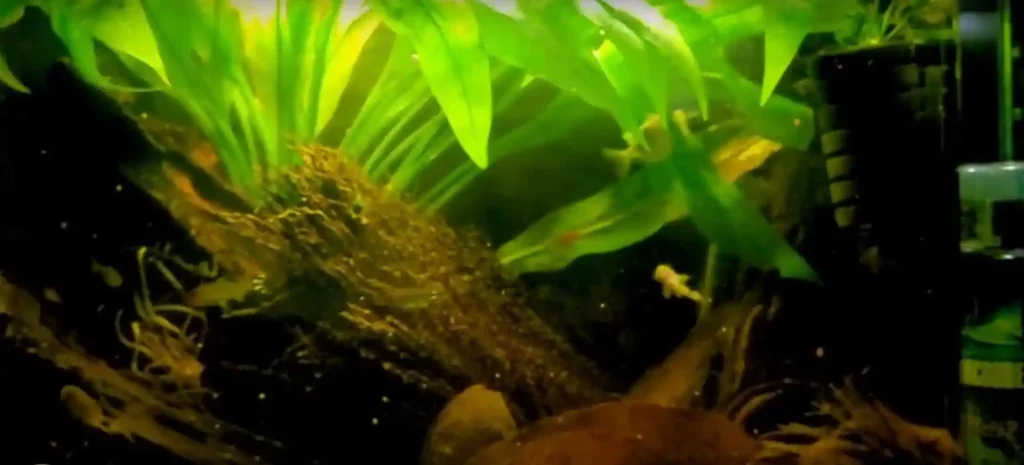What is a Blackwater Aquarium?
A blackwater aquarium is a type of freshwater aquarium that mimics the natural conditions of dark, acidic, and soft water habitats. These habitats are found in some parts of the world, such as the Amazon basin, where rivers, streams, and ponds are stained with tannins and humic acids from decaying plant matter.
Tannins and humic acids are organic compounds that lower the pH and hardness of the water and give it a brownish or yellowish color. Some fish species have adapted to live in these blackwater environments and can benefit from having similar conditions in their aquariums.
Blackwater Aquariums Beginners Guide
Making a blackwater aquarium is not very difficult, but it requires some planning and preparation. Here are the basic steps to set up a blackwater aquarium:
Choose a suitable tank size and shape

The tank size depends on the number and type of fish you want to keep, and the shape depends on your preference and space availability. Generally, a long and shallow tank is better than a tall and narrow one, as it provides more surface area and oxygen exchange.
Choose a suitable substrate

The substrate is the material that covers the bottom of the tank, and it can affect the water chemistry and the appearance of the tank. For a blackwater aquarium, you should avoid substrates that contain limestone, coral, or shells, as they can raise the pH and hardness of the water.
Instead, you should use substrates that are inert, such as sand, gravel, or peat. Peat is a type of soil that contains a lot of organic matter, and it can help lower the pH and release tannins into the water.
Choose a suitable filter

The filter is the device that cleans the water and removes waste and toxins. For a blackwater aquarium, you should use a filter that has a good biological and mechanical filtration capacity, but a low chemical filtration capacity.
This is because you want to keep the tannins and humic acids in the water, and not remove them with activated carbon or other chemical media. You can use a powerhead, a canister filter, or a sponge filter for your blackwater aquarium.
Choose a suitable heater

The heater is the device that regulates the temperature of the water. For a blackwater aquarium, you should use a heater that can maintain a stable and appropriate temperature for your fish.
The temperature range depends on the species you want to keep, but generally, most blackwater fish prefer temperatures between 22°C and 28°C (72°F and 82°F).
Choose a suitable lighting

The lighting is the device that provides light for the tank. For a blackwater aquarium, you should use lighting that is dim and subdued, as blackwater habitats are usually shaded by dense vegetation.
You can use LED lights, fluorescent lights, or incandescent lights for your blackwater aquarium, but you should adjust the intensity and duration according to your fish and plant needs.
Choose a suitable source of tannins and humic acids
The source of tannins and humic acids is the material that you add to the water to create the blackwater effect. There are many options for this, such as driftwood, Indian almond leaves, oak leaves, alder cones, beech cones, peat pellets, or bottled tannins.
You can use one or more of these sources depending on your preference and availability. You should soak them in water before adding them to the tank, to remove any dirt and excess tannins. It would be best if you replace them regularly, as they will decompose over time and lose their effectiveness.
Choose a suitable water source
The water source is the water that you use to fill and change the water in the tank. For a blackwater aquarium, you should use water that is soft and acidic, as hard and alkaline water can neutralize the effects of the tannins and humic acids.
You can use distilled water, reverse osmosis water, or rainwater for your blackwater aquarium, but you should test the water parameters before using it. You should also use general hardness-reducing resins, such as peat granules or ion exchange resins, to soften the water if necessary.
Choose suitable plants

The plants are the living organisms that you add to the tank to provide oxygen, shelter, and decoration. For a blackwater aquarium, you should choose plants that can tolerate low light and acidic water conditions, such as Anubias, Java fern, Java moss, Cryptocoryne, or Echinodorus.
You should also choose plants that are compatible with your fish, as some fish may eat or uproot them. You should plant them in pots or attach them to driftwood or rocks, as the substrate may not be suitable for their roots.
Choose suitable fish

The fish are the living organisms that you add to the tank to provide life, color, and movement. For a blackwater aquarium, you should choose fish that are native to blackwater habitats and can thrive in low pH, soft water, and dim light conditions.
Some examples of blackwater fish are tetras, rasboras, hatchetfish, corydoras, discus, gourami, apistogramma, and other dwarf cichlids. You should also choose fish that are compatible with each other, as some fish may be aggressive or territorial. You should research the specific needs and behaviors of each fish before adding them to the tank.
How to Test and Maintain a Blackwater Aquarium

Testing and maintaining a blackwater aquarium is similar to testing and maintaining any other freshwater aquarium but with some differences. Here are some tips to test and maintain a blackwater aquarium:
Test the water parameters regularly
The water parameters are measurements of the water quality and chemistry, such as pH, hardness, ammonia, nitrite, nitrate, and temperature. For a blackwater aquarium, you should test the water parameters at least once a week, using water test kits or digital meters.
You should aim to keep the pH between 5.0 and 6.5, the hardness between 0 and 4 dGH, the ammonia and nitrite at 0 ppm, the nitrate below 20 ppm, and the temperature between 22°C and 28°C (72°F and 82°F). You should also monitor the color and clarity of the water, as they may change over time due to the tannins and humic acids.
Change the water regularly
Water change is the process of removing some of the old water and replacing it with new water, to dilute the waste and toxins and replenish the minerals and oxygen. For a blackwater aquarium, you should change the water at least once every two weeks, using a siphon or a gravel vacuum.
You should change about 25% to 50% of the water, depending on the size and stocking of the tank. You should also use water that has the same parameters as the tank water, to avoid shocking the fish and plants. You can use a bucket or a hose to transfer the water, but make sure to dechlorinate it if necessary.
Clean the filter regularly
Filter cleaning is the process of removing the dirt and debris that accumulate in the filter media, to improve the water flow and filtration efficiency. For a blackwater aquarium, you should clean the filter at least once a month, using a brush or a cloth.
You should also rinse the filter media in old tank water, not tap water, to preserve the beneficial bacteria that live in them. You should replace the filter media only when they are worn out or damaged, not when they are dirty, as they contain the tannins and humic acids that you want to keep in the water.
Replace the source of tannins and humic acids regularly
Source replacement is the process of removing the old and exhausted source of tannins and humic acids and adding a new and fresh one, to maintain the blackwater effect and the water parameters.
For a blackwater aquarium, you should replace the source of tannins and humic acids at least once every two months, depending on the type and amount of the source. You should also soak the new source in water before adding it to the tank, to remove any dirt and excess tannins.
What are the benefits of a blackwater aquarium?
A blackwater aquarium has many benefits, both for the fish and the hobbyist. Here are some of the benefits of a blackwater aquarium:
1. Natural and comfortable environment
It provides a natural and comfortable environment for the fish. A blackwater aquarium replicates the natural habitat of many fish species, such as tetras, discus, and apistogramma. These fish have evolved to live in dark, acidic, and soft water conditions, and can benefit from having similar conditions in their aquariums.
A blackwater aquarium can reduce stress, improve the fish’s health and color, and encourage their natural behaviors and breeding.
2. Unique and Stunning look
It provides a unique and beautiful aesthetic for the hobbyist. A blackwater aquarium offers a different and stunning look for the hobbyist, compared to the typical clear and bright aquariums. A blackwater aquarium has a mysterious and serene vibe, with the contrast between the dark water and the colorful fish and plants.
To create a realistic and attractive biotope, a blackwater aquarium can also be decorated with various natural materials, such as driftwood, leaves, cones, and pods.
3. Learning opportunity
It provides a challenge and a learning opportunity for the hobbyist. Compared to the standard freshwater aquariums, a blackwater aquarium is not very common or easy to set up and maintain.
A blackwater aquarium requires some research and experimentation, as well as some special equipment and materials, to create and sustain the blackwater effect and the water parameters.
A blackwater aquarium also allows the hobbyist to explore and learn more about the diverse and fascinating blackwater habitats and fish species, and their adaptations and behaviors.
What are the disadvantages of a blackwater aquarium?
A blackwater aquarium also has some disadvantages, both for the fish and the hobbyist. Here are some of the disadvantages of a blackwater aquarium:
- It requires more maintenance and monitoring than a typical aquarium, as the water parameters need to be kept stable and the organic matter needs to be replenished regularly.
- It may not be suitable for some fish species that prefer clear and alkaline water, such as livebearers, cichlids, and goldfish.
- It may reduce the visibility and vibrancy of some fish and plants, as the dark water can make them look duller or less colorful.
- It may pose some health risks for the fish and the aquarist, as the decaying organic matter can harbor harmful bacteria, fungi, or parasites, and the acidic water can irritate the skin or eyes.
Limitations of blackwater aquarium
- It limits the choice and compatibility of fish and plants. A blackwater aquarium is suitable only for fish and plants that can tolerate low pH, soft water, and dim light conditions, such as those from blackwater habitats. A blackwater aquarium is not suitable for fish and plants that prefer high pH, hard water, and bright light conditions, such as those from alkaline lakes or coral reefs. A blackwater aquarium also requires careful selection and combination of fish and plants, as some may have different requirements or may not get along well with each other.
- It reduces the visibility and coloration of fish and plants. A blackwater aquarium has a dark and murky appearance, due to the tannins and humic acids in the water. A blackwater aquarium may make it harder to see and appreciate the fish and plants in the tank, especially if they are small or have dark colors. A blackwater aquarium may also affect the coloration of some fish and plants, as they may lose some of their brightness or contrast in low light and dark water conditions.
- It increases the risk and difficulty of monitoring and maintaining the water quality. A blackwater aquarium has a low pH and soft water, which are more prone to fluctuations and instability than neutral or alkaline water. A blackwater aquarium also has a high organic load, due to the decomposition of the source of tannins and humic acids, as well as the waste and food of the fish and plants. A blackwater aquarium may increase the risk of ammonia spikes, nitrate accumulation, fungal infections, and other water quality issues. A blackwater aquarium also requires more frequent and careful testing and changing of the water, as well as cleaning and replacing the filter and the source of tannins and humic acids.
Conclusion
A blackwater aquarium is a type of freshwater aquarium that mimics the natural conditions of dark, acidic, and soft water habitats. A blackwater aquarium has many benefits and disadvantages, both for the fish and the hobbyist. A blackwater aquarium can provide a natural and comfortable environment for the fish, a unique and beautiful aesthetic for the hobbyist, and a challenge and a learning opportunity for both.
A blackwater aquarium can also limit the choice and compatibility of fish and plants, reduce the visibility and coloration of fish and plants, and increase the risk and difficulty of monitoring and maintaining the water quality. A blackwater aquarium is not for everyone, but it can be a rewarding and enjoyable experience for those who are willing to try it.






